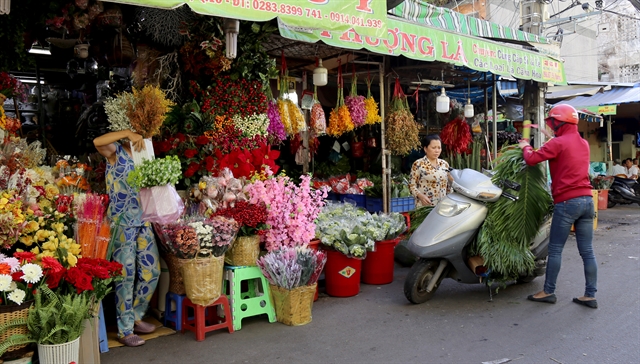 Society
Society


|
| Hồ Thị Kỷ Flower Market in HCM City’s District 10. District authorities in HCM City will issue rental rates for stalls in traditional markets. —VNS Photo Ngọc Diệp |
HCM CITY — The HCM City People’s Committee has assigned districts to set rental rates for stalls in traditional markets for a maximum 10-year period.
Last year, the city’s Department of Industry and Trade proposed issuing rental fees for stalls at traditional markets that receive funding from the State budget.
Fees will be set according to the type of market. First-class markets with over 400 businesses are managed by the city authority, while second-class markets with 200 to 400 businesses are managed by district authorities. Third-class markets are managed by authorities of communes or wards.
At first-class markets, a stall owner would pay a monthly fee of VNĐ200,000 (US$8.5) per square metre and a daily fee of VNĐ8,000 ($0.34) per sqare metre.
For second-class markets, the fee would be VNĐ140,000 ($6) per sq.m per stall each month and VNĐ4,000 ($0.17) per sq.m per day.
The monthly rental fee would be VNĐ100,000 ($4.3) per sq.m, and the daily fee VNĐ2,000 ($0.08) per sq.m at third-class markets.
For markets financed by non-State sources, the rental rates can be set higher, but cannot be two times more than the rates at State-funded markets.
There are 240 traditional markets in the city that sell many kinds of food and household items.
The city has banned the opening of more traditional markets, but will upgrade existing markets to ensure hygienic standards, and adherence to food safety and origin regulations.
Three wholesale markets, Bình Điền, Thủ Đức and Hóc Môn, will become import and export centres and be open to tourists.
Traditional markets play an important role in the city’s distribution system and also reflect the city’s cultural values.
Fees for land areas
The HCM City People’s Committee has approved a plan to set new prices and fees for land areas beginning on January 1, 2020.
The 2020 pricing table will be used for the next five years to calculate the land price when the State grants land-use rights to households and individuals, as well as for the transfer of agricultural or non-residential land to residential land.
The table will also be used for the calculation of land taxes, management fees, fines for violations and other usages.
Different price ranges exist for different kinds of land such as protection forests, rivers and canals for aquaculture, and land for business purpose.
The pricing table will be based on existing streets and alleyways, and agricultural land.
New street names will be added and the price of land plots will be updated from the 2015 pricing table so that they line up with the Government’s pricing range.
The price of land at the borders of districts that have underdeveloped infrastructure and economy will also be adjusted.
The city will work with surrounding provinces such as Long An, Đồng Nai and Bình Dương to map out the border land areas and determine land prices. — VNS




